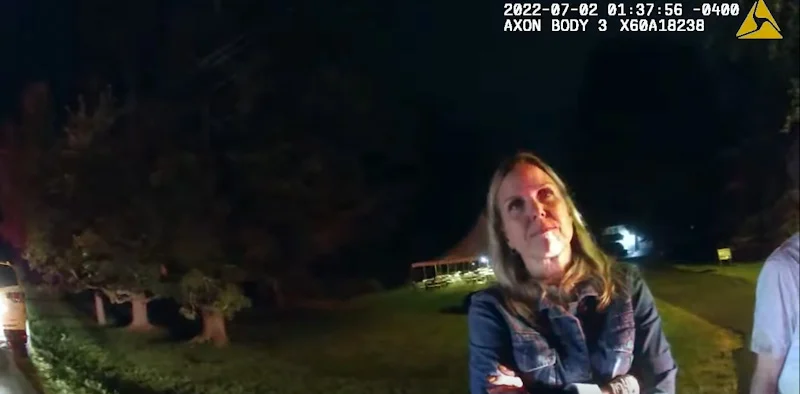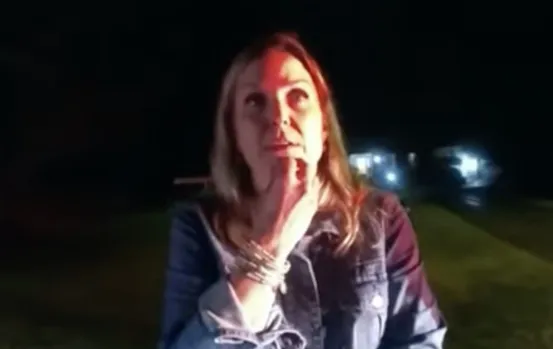Related Posts
A recent video release shows a New York Judge threatening to shoot four teenagers after a graduation party. The clip comes from body camera footage released by the New York State Commission on Judicial Conduct.
The republican judge, Erin P. Gall, presides in the State Supreme Court in Oneida County. The original incident occurred in July 2022, although the footage and current scandal are relatively recent.
The judge had attended a graduation party with her husband and three children. According to the police story, four black teenagers later arrived at the party. These teenagers learned about the event through a live video feed and were not initially invited.
At the party, there was an incident involving Judge Gall’s son and likely one or more of these teenagers. Information regarding the teenager’s status in the incident cannot be concluded for certain. As the police arrived, the teenagers were supposedly looking for their lost keys. During this, the judge continued yelling at the children, demanding they leave the property.
As the event dragged along, the conflict only increased. Judge Gall’s demands quickly turned into threats. She told the police, “You can shoot them on the property [if they come back].” When they shot down her sinister offer, she then went further, threatening, “I’ll shoot them on the property.”
In addition to her threats and remarks, Gall attempted to use her position as a bargaining chip in the interaction. In front of the teens, she revealed her status as a judge and said, “Listen, but guess what, the good part is – the good part is I’m always on your side…You know I’d take anyone down for you guys. You know that. You know I am on your side.”
Public Outcry Against New York Judge Gall
The released footage has taken the internet by storm, sparking heated responses. Most directly oppose the judge, criticizing her unnecessary behavior. Some prominent figures and judicial authorities have even reacted to the incident.
One big player making waves in this discussion is American rapper 50 Cent. The artist took to Instagram, creating a post to bring awareness to the incident. He reposted the video to his account with the caption, “SMH, she should be removed.” He then urged his followers to do the same. “This is bad. Repost this video,” he wrote.
In addition to the famed rapper, the State Commission on Judicial Conduct has also become aware of the issue. With the evidence at hand, the commission has stated that her actions have at least created the appearance of racial bias in her character.

According to the commission’s report, “Her wide array of misconduct severely undermined public confidence in the judiciary and in her ability to serve as a fair and impartial judge.” The commission’s administrator even responded to the incident, saying, “[Erin Gall’s behavior] was as shocking as anything I have seen in my 40 years of judicial ethics enforcement.”
As it stands, the New York Judge is facing possible removal by the commission. According to CBS, Gall’s attorney plans to appeal the ruling for her removal. Ultimately, Gall must wait to see how the commission responds to the evidence against her.
Are The Judge’s Threats Illegal?
In such situations, determining the legalities of people’s actions can be rather difficult. As tensions rise, people often make empty threats and arguments that can verge on the grounds of being criminals. In the worst cases, all parties involved may stand their ground legally while also breaking other laws. So, in the case of Judge Gall, were her threats illegal?
The judge’s threats could fall under a “criminal threat” status, although it is unlikely that any charges would stick. For a threat to be criminal, it has to meet a few requirements, such as:
- Threats must consist of violent means such as murder, injury, harm, kidnapping, arson, etc.
- Threats must incite fear, intimidate, or coerce the victim earnestly.
- Threats must warrant a reasonable belief that the speaker intends to act upon it.
While Judge Gall made these threats with passion and anger, it could be easily proven that she didn’t mean what she said. Likewise, since she didn’t take any action to make it reasonable to believe she would go through with the treat, one could argue her words fall under the First Amendment.
With that said, in the event she were to brandish a weapon or make her threat more tangible, there would certainly be grounds for a criminal case.
Judge Gall and the Castle Doctrine

As shown in the police footage, some of Judge Gall’s actions appear as though they may fall under the castle doctrine. This doctrine is a classic piece of legal tort that outlines when someone can use lethal force to protect themselves. It is so infamous and widespread that most states have codified or made amendments to it within their laws.
Under the basic idea, the doctrine exempts one from the duty to retreat in place of using lethal force to protect themselves. This is only true when the person is under the belief that they are under lethal threat themselves. Additionally, the doctrine only permits one to use an appropriate amount of force to deter the threat. As mentioned before, these rules and guidelines may vary from jurisdiction to jurisdiction.
Despite the New York Judge’s actions that seemingly fall under the castle doctrine, there are a few important things to note. Firstly, the house she was at was not her own, meaning she would likely fall under the duty to retreat if there were a threat.
Likewise, the teenagers were likely not exhibiting a lethal threat to the woman. Although they did possibly get involved in an altercation on the property, they didn’t brandish a weapon and did not threaten the woman. For these reasons, Judge Gall’s actions would likely not fall under the castle doctrine if she were to issue lethal force on the teenagers.
While it is comforting to hear no one was injured in the incident, it does raise questions about the ethics of our elected and appointed officials. With the Judge’s status in jeopardy, it will be interesting to see how the Judicial Commission views her eligibility to act fairly in the New York Supreme Court.

